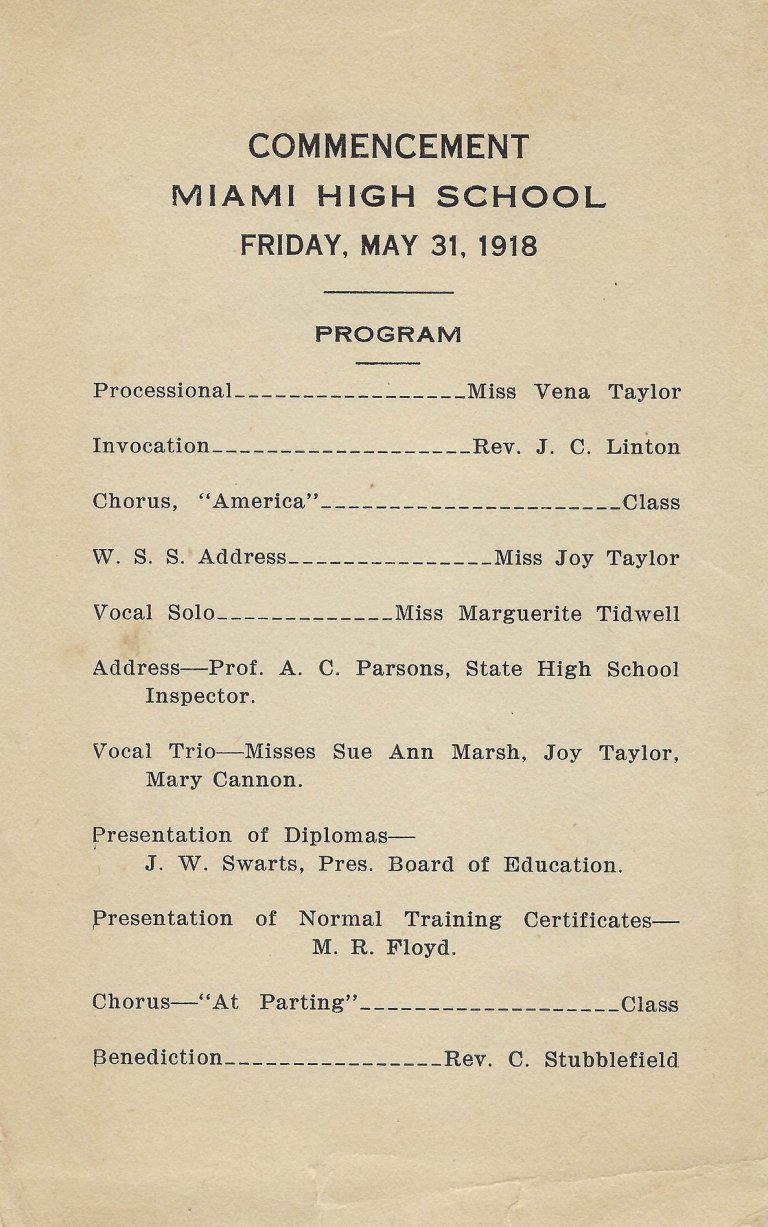A park area has long existed at the extreme south end of Main Street. Photos can be seen of families at the river’s edge in the teens, just south of the first bridge to span the Neosho, very close to the present-day southern bridge’s location.
But on September 1, 1917, Riverview Park officially opened.
Possibly as early as the teens, a small pool and poolhouse was built close to the edge of the river, just north of where the east dam steps are. While flooding was less common in those days, the river did come out of its banks every few years. When discussions took place regarding the location of a huge new pool in 1929, concern was expressed that it be placed in an area less prone to flooding.
In 1923, the concrete dam was built, forming Lake Miami on the free flowing river, and causing spoonbill to gather in huge numbers at the south side, unable to swim upstream for the first time in history.
A tourist camp sort of sprang up on its own at the present day site of the park on the east side of the river. These were common in towns when automobiles were becoming more commonplace. A family could park, pitch a tent, and spend the night before moving on the next morning. When the Great Depression hit, it became home to displaced folks who lost their homes. In 1930, the city announced that the tourist camp would be closed, and the folks down on their luck were force to move on.
“A condition of disease, filth, and pilfering exists at the park now which makes a sore on an otherwise clean and healthy city” according to mayor W.L. Rush.
But the process wasn’t instant. A June 1931 editorial bemoaned the fact that transients still had tents pitched and permanent summer homes at the park, displacing residents seeking recreation.
In 1930, that huge new pool opened up, and the fact that it is still used today testifies to its amazing design and quality. Our founders didn’t foresee Pensacola Dam, otherwise they might have located the pool elsewhere, but still, it’s not common for floods to inundate it where it sits.
By 1932, the park was 50 acres in size, on both sides of the Neosho. Lowland grounds were left unmaintained, and improvements were made to higher areas. Four concrete tennis courts were added that year.
In 1933, an Old Settlers Reunion was held at the park. Attending were Harry Lykins, son of the town co-founder, as well as around 250 residents and their descendants who were around in 1891.
A 1934 newspaper article mentions Sunday school being held at a “big” tabernacle at the park, with expected attendance of 250. It was mentioned again in a 1935 article. But no other mentions were made of that tabernacle that I can find.
In 1937, Riverview Park was home to a small zoo run by Grove resident C.F. Tucker. The zoo had 32 animals when opened. These included a camel, llamas, elk, and reindeer.
The pavilion building just southwest of the swimming pool was likely built as a WPA project in the 30’s.
Riverview continued to be the city’s gathering place through the 40’s and 50’s. Land acquisitions caused it to periodically increase in size. In the early 60’s, a steel submarine was erected by the WPA-built pavilion. And in 1966, a beautiful Mid Century Modern pavilion was built.
Riverview Park continues to be a treasured Miami gathering spot today. The dam, approaching 100 years old, is occasionally seen sticking out of the waters now backed up by Pensacola dam. Fishermen line its banks every spring during spoonbill season. And I’ve observed courageous young men wading the river retrieving lost hooks and sinkers, while big spoonbill bump into them in their travels. The park isn’t quite as old as the city, but will remain a part of it as long as the city lasts.











 The first fair took place in Miami on September 24, 1910. It was simply an exhibit of farmers’ products, judged as to quality. A somewhat larger exposition was held the next year in October. In 1912, the Farmers Institute and Ladies Auxiliary of Ottawa County voted to hold their exhibition of mineral, stock, and agricultural products on October 3-5 of that year at “Riverside Park,” as the park at the south end of Main was known. The 1913 fair was held at Afton. There was no mention of a fair in 1914, other than a single ad in the Live Wire asking if it should be held. They did that the previous three years as well.
The first fair took place in Miami on September 24, 1910. It was simply an exhibit of farmers’ products, judged as to quality. A somewhat larger exposition was held the next year in October. In 1912, the Farmers Institute and Ladies Auxiliary of Ottawa County voted to hold their exhibition of mineral, stock, and agricultural products on October 3-5 of that year at “Riverside Park,” as the park at the south end of Main was known. The 1913 fair was held at Afton. There was no mention of a fair in 1914, other than a single ad in the Live Wire asking if it should be held. They did that the previous three years as well.





















